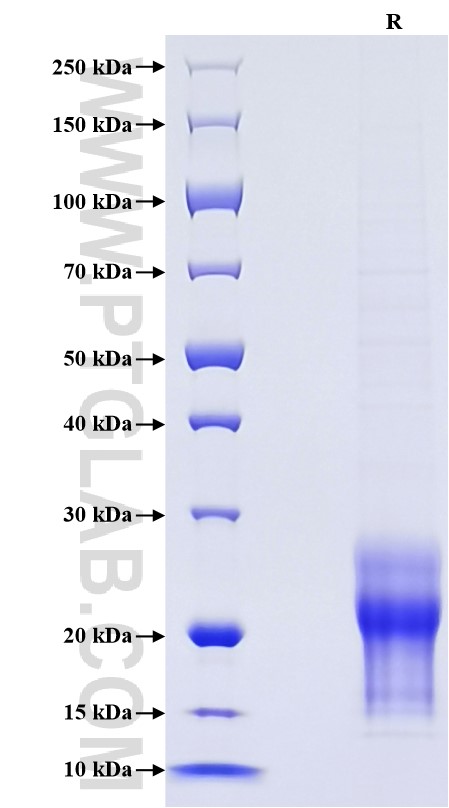Recombinant Human MCP-1/CCL2 protein (Myc Tag, His Tag)
种属
Human
纯度
>90 %, SDS-PAGE
标签
Myc Tag, His Tag
生物活性
未测试
验证数据展示
产品信息
| 纯度 | >90 %, SDS-PAGE |
| 内毒素 | <0.1 EU/μg protein, LAL method |
| 生物活性 | Not tested |
| 来源 | HEK293-derived Human MCP-1 protein Gln24-Thr99 (Accession# P13500) with a Myc tag and a His tag at the C-terminus. |
| 基因ID | 6347 |
| 蛋白编号 | P13500 |
| 预测分子量 | 13.7 kDa |
| SDS-PAGE | 15-27 kDa, reducing (R) conditions |
| 组分 | Lyophilized from 0.22 μm filtered solution in PBS, pH 7.4. Normally 5% trehalose and 5% mannitol are added as protectants before lyophilization. |
| 复溶 | Briefly centrifuge the tube before opening. Reconstitute at 0.1-0.5 mg/mL in sterile water. |
| 储存条件 |
It is recommended that the protein be aliquoted for optimal storage. Avoid repeated freeze-thaw cycles.
|
| 运输条件 | The product is shipped at ambient temperature. Upon receipt, store it immediately at the recommended temperature. |
背景信息
Monocyte chemotactic protein 1 (MCP1; also known as CCL2), is a chemokine that can be expressed in monocytes, macrophages, and endothelial cells, and belongs to the CC subfamily of chemokines. Chemokines are a superfamily of secreted proteins involved in immunoregulatory and inflammatory processes. Research has shown that the expression of MCP1 increases in the serum of patients with acute myocarditis. MCP1 is up-regulated in many types of CNS injury, including ischemia, hemorrhage, trauma, infection, hypoxia, and peripheral nerve axotomy. MCP1 has also been implicated in the pathogenesis of diseases characterized by monocytic infiltrates, such as psoriasis, rheumatoid arthritis, and atherosclerosis.
参考文献:
1. Sørensen T. et al. (2004) Eur J Neurol. 11: 445-9. 2. Kusano KF. et al. (2004) Circ J. 68: 671-6. 3. Hayashida K. et al. (2001) Arthritis Res. 3: 118-26. 4. Dimitrijevic OB. et al. (2006) J Cereb Blood Flow Metab. 26:797-810. 5. Mahad DJ. et al. (2003) Semin Immunol. 15:23-32.
